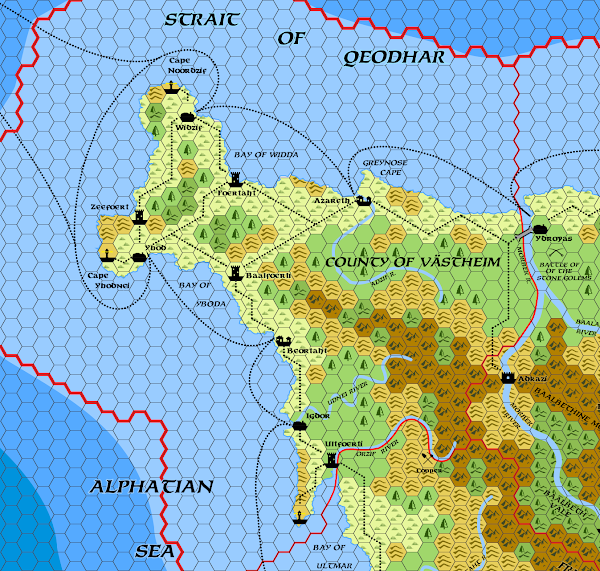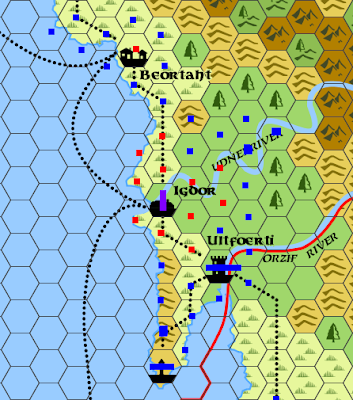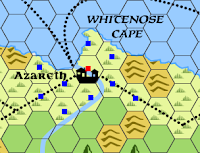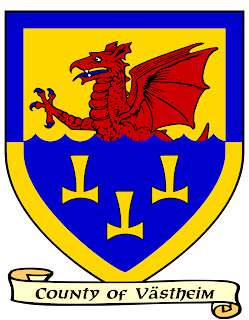Continued from "The Marquisate of Azafeth"
At the tip of the northwestern corner of Alphatia lies the land of a conquered people yearning to regain their freedom. But what can an isolated culture truly hope to gain in the face of the mighty Alphatian Empire?
At the tip of the northwestern corner of Alphatia lies the land of a conquered people yearning to regain their freedom. But what can an isolated culture truly hope to gain in the face of the mighty Alphatian Empire?
 |
| County of Västheim -- Map Scale: 8 Miles per Hex |
Original settlers were Antalians, fearless navigators and warriors who’d sailed eastward from faraway Brun. They’d named this land Østheim centuries ago, although it later became known as Västheim (pronounced VEST-high’m), the Kingdom of the West, reflecting an Alphatian point of view. It is only one of many changes imposed by the wizardly conquerors. The present county dates back to the establishment of Greater Frisland as a subject kingdom of the Alphatian Empire, centuries after the fall of the old Antalian kingdoms. Since then, the inhabitants have become somewhat more mixed in their cultural and racial heritage. Dark-haired and pale skinned Alphatians as well as copper skinned Cypric have mixed with local Antalians, showing Yanifey influences as well. In Västheim, the Ogam seem like a distant peril, an ugly and shameful disease that struck their southern cousins which, thankfully, has been averted here. In the minds of the locals, it instilled a concept that their land is therefore unsoiled, somehow holier, and more righteous than their neighbors’. Västheim’s relative economic strength, at least from a Frislandic point of view, only helps reinforce this strong parochial mentality.
Coastal areas from Foertaht around the peninsula and all the way down to the border with Azafeth are almost entirely settled. Population is relatively homogenous, including a majority of fair complexioned people. Among commoners, the main group strongly identifies with their Antalian ancestry. A minority of mixed-Alphatian or Yanifey origins remains relatively neutral and discreet. The latter is the prevailing ethnic in and around the village of Azareth and along the border with the Duchy of Wyllareth. Dwarves and elves are welcome and present throughout the county. Aristocracy is exclusively and unmistakably Alphatian, priding itself in its lineage to Houses dating back to the Age of Landfall. As in most nations of Alphatia, little love is lost between nobles and commoners, regardless of their actual ancestries. Temples honoring such immortals as Odin, Thor, Loki, and others associated with Antalian culture are most common in Västheim.
Västheim’s urban centers include Ybod (9,000 people), Widzif (7,400 people), Igdor (5,300 people), and the villages of Azareth and Beortaht, for a total population of more than 176,000 Västheimers. Much of the business in this county relies on fishing all along the coast, and shipbuilding, especially in Igdor (pronounced EEG-dohr). Original forests have been largely depleted in the area, causing a demand for Azafethian lumber. The seat of the county, Ybod (pronounced YEE-bohd), is a trading center and a major source of income. The count’s palatial tower stands on a rocky spur at the town’s center, overlooking the port area as a symbol of Alphatian authority. It is rumored to contain fully grown trees of various breeds within its walls. None among common folk know why. Beortaht is notorious as a source of tame bears and ursine pelts popular among the county’s wealthy. All these places commonly feature Antalian architecture and style. Due to lack of wood, stone dwellings are more common than in Azafeth, with grass growing on the roofs. A goat or two grazing on top of one’s residence is a common sight in the region. Native livestock is stout and shaggy. Blasé and scornful Alphatians often jest about native females’ legs fitting the same description, while the latter think of noble folk as effeminate fops.
Four large towers stand at key points of the trails connecting Västheim’s urban centers, both to keep an eye on who goes by and to collect tolls. All towns and villages are fortified, usually a wood palisade with a ditch and few watchtowers for villages, and a more elaborate mix of wooden and stone structures for towns. The main reason for these defenses lies in the fear of Qeodim raiders, which easily exceeds risks of an Ogam attack or potential wars with neighboring dominions. Though nearby Qeodhar is yet another province of Alphatia, piracy remains the primary danger in these parts. Sea monsters aren’t rare either. From King Edjer’s point of view, Västheim is the kingdom’s cash cow. He uses all means available to extort as much gold as possible, while holding the count directly responsible for handling the Qeodim nuisance on the seas.
Armed Forces of Västheim: They amount to nearly 2,200 troops including army and navy. The bulk of these forces hold the three towns. The county’s fleet includes a war galley, two large galleys, four longships, two skyships, in addition to one small sail ship, one large sail ship, and one troop transport. The majority of these vessels hail from Ybod; one skyship operates from Widzif and the other from Igdor. Aside from monitoring a coastline more than 500 miles long, the navy’s main mission is to patrol the Strait of Qeodhar, especially in the vicinity of Cape Noordzif. The skyship based in Igdor, the Viggen, spends half its mission time near the forty-mile-mountain-stretch bordering the northern Baalbeth Valley, to reduce chances of Ogam infiltration in these parts. An aging skyship at Widzif, the Draken, hunts for sea raiders. There has been talk of a special tax to raise funds for the construction of a third and more powerful skyship, the Grippen. The decision has yet to be made as the move has proven wildly unpopular among the common population.
Based on the dominion’s population makeup, it is a foreign region under occupation. Unlike other dependencies of the empire, Greater Frisland has had problems attracting enough people from the south to absorb local culture. Poor lands, bad climate, and an appalling reputation have done much to accomplish this. Nowhere in Alphatia is this situation more relevant than with Västheim. Under these circumstances, it was a foregone conclusion that natives here would seek better conditions for themselves, at least from a political standpoint. This struggle led to the genesis of the Scions of Antalia, a secret sect of ethnic Antalians seeking greater autonomy from the empire. It stands as a key divisive force in Greater Frisland and Alphatia as a whole.
The Scions’ goal is to force the empire to negotiate for the removal of ethnic Alphatian aristocracy from Västheim in favor of a council-led-leadership chosen by a system representing the people, the military, and the clergy. Although intended as an ally of the empire in the matters of foreign policy and commerce, this new political entity would be autonomous and sovereign under old Antalian laws. At this point in time (AC 1000), Sundsvall would never agree to any such scheme. The concept of allowing a subject kingdom, or a part of one, to become autonomous stands as an invitation for others to request the same. If it weren’t a death sentence for the empire, it would come dangerously close to it.
As a result of this impasse, early proponents of Antalian autonomy were hunted down and executed for sedition, forcing survivors to go underground and adopt extremist attitudes. Thus came into play the Scions of Antalia. Their sect survived all suppression attempts thanks to tacit popular support. Since Sundsvall, let alone Shiell and Alphatian aristocracy in Västheim, will not willingly negotiate, then force must be used to bring them to the table. The Scions’ strategy involves assassinations, machinations aimed at weakening the empire, targeting imperial interests abroad, sedition at home, and most dangerously, colluding with the Ogam. In exchange for the absence of Ogam depredations in Västheim, the Scions of Antalia pay the northern tribes with various goods of value to them including especially Alphatian abductees and tactical information about neighboring Wyllareth, Osseta, and Frisia. Northern Ogam tribes have been interested particularly in details about an order of Wyllarethian paladins who have been a thorn in their flank for a long time.
One might think this strategy of collusion to be self-defeating, except that the Scions have an ulterior motive. As they secretly trade with the Ogam, they collect a good amount of intelligence against them, which may provide a crucial bargaining chip when negotiations with the empire become possible. Oddly, the Ogam have indeed lowered their guard as they grew accustomed to dealing with these subversives. Information handed to the Ogam could just as easily be used to set up an elaborate, large-scale trap, and strike a blow that could strip the north of the hated goat herders.
Librarian seekers have become aware of links between the Ogam and the Scions, but exposing the latter’s leadership remains a challenge for local teams. Qeodim and Thyatian spies have infiltrated the sect, to help drive it into their masters’ arms. Scions of Anatalia are aware of this and manipulate these spies to disinform their respective leaders and exploit beneficial opportunities. Scion activists operate in Qeodhar for the purpose of removing Alphatian hegemony from the island as well, and in northern Azafeth for the same reason. The plan is to establish a state stretching from Farend to Wykstaht, if not to the border with Limn. Crones and other soothsayers unwittingly serving Odin, Thor, Frey, or Freyja largely influence the Scion movement. They also lie at the heart of factions within the sect. Followers of Loki might seek to expose the Scions’ scheme for the purpose of fostering chaos and conflict—such traitors present in fact the greatest liability for the sect, though it was the one which initially suggested the double strategy of collusion and sedition. All said, Scions of Antalia are opportunistic, brutal, ruthless, and prejudiced extremists who stop at nothing to reach their aims.
Lord Sidharram, Count of Västheim
The House of Sidharram stands among the oldest Alphatian families. Yet, it does not dwell in Vertiloch among its peers, nor has it been seeking to do so. Though Alphatian nobles in Frisland, and even more so in Västheim, pride themselves of their ancient wizardly pedigrees, they often bear some flaw in the eyes of their compatriots. As a result, their forebears were granted Frislandic domains to keep them away from Sundsvall, or simply decided to live in these unpopular parts to pursue a discreet existence, away from the empire’s immediate scrutiny. Such is the case for the House of Sidharram.
It so happen that a distant ancestor had crossed paths with a Fey while exploring the clan lands of Foresthome. Their union yielded a magical and unique bloodline. The House’s original name, Martharram, therefore changed to Sidharram (pronounced SHEE-tharam). Its descendents could be described as "half-elves," neither quite as graceful as elves, nor as tall as humans, yet with Alphatian fair skin and black hair. The magical nature of this bloodline only manifests itself when a family heir inherits the House’s title and assets. Faerie genes are recessive among those who aren’t fully Fey, except for the rightful head of this House. Descendants of the family in other branches eventually revert to their Alphatian form, though the Fey’s arcane sap forever flows in their veins. In the event the current family failed to yield an heir, the progeny of the next in line would be born as a half-elf with the Fey’s magical legacy waiting to rouse once more.
Another peculiarity concerns the matter of death and revival. A Sidharram who perishes can always be raised from the dead and returned to life, as is common among well-to-do Alphatian aristocracy. However, while a rightful heir is alive, a forebear’s death becomes final whenever it should happen. At that time, the body disintegrates, and powerful roots take hold, no matter the terrain. Soon, a regal tree grows in the place of the fallen and exudes a vital force bringing about a carpet of grass, moss, and ferns a good ten feet out. It explains why trees have grown inside the seigneurial tower, sometimes in terribly awkward places. When this happens, surrounding architecture is modified to accommodate the parents’ final resting places, giving the count’s abode a strange, twisted appearance. It is said that family ghosts awake from their funeral trees on the anniversary of their deaths, though a nearby disturbance might provoke the same.
These family oddities earned the House of Sidharram lands granted in faraway Västheim, as a way to keep its un-Alphatian character from further soiling the more ancient bloodlines of Vertiloch. On the other hand, this curious twist of nature generated a strong and secret bond between Sidharram and the Fey of Foresthome—sworn enemies of the Ogam. The count fiercely opposes the Scions of Antalia, as he knows for a fact that they deal with the Ogam and betray his Alphatian kinsmen. The abduction of wizards and their subsequent sacrifices at the hands of the odious shamans provoke the count’s bitterest sentiments. Yet more painful remains his inability to strike down the hated sect. The present count, in his mid-twenties (a youngster in Fey terms), isn't married and hasn’t produced as of yet a rightful heir to his House. His natural allure easily earns him the opposite gender’s eager attentions. His wildly changing moods, however, can be hard to manage, and many an idyll has foundered as a consequence. It’s in his nature.
The count’ s magical bloodline causes his alignment to vary from Lawful in summer, to Neutral in spring and fall, and Chaotic in winter (family ghosts retain the alignments corresponding to the time of their deaths). The count also receives a 25% anti-magic resistance and the ability to speak with plants once per day, as the spell. Preferred clothing generally reflects seasonal colors (gold and dark green in summer, rust and brown in the fall, white, blue, and silver in winter, and pale green in the spring). The count remains immune to the innate powers of wood nymphs (blindness and death). Using D&D game rules, treat the count as an elf.
Appearance: Sidharram stands about five feet eight inches, and has the typical blue-black hair and pale skin of the Alphatian side of his heritage. His eyes' color changes with the seasons, and hence with his moods: in spring, they appear almost light green with a bluish cast; in summer, bright amber; in fall, deep sorrel; and icy blue in winter. His wide forehead tapers to a stubborn chin. Clenching his teeth, which makes his cheeks appear hollow, is a sure sign of displeasure. So is the bluish vein that pulses in his left temples when his ire rouses. Spring brings Sidharram a boost of extroverted energy, as if he needed to clean house and make certain everything were in order for the rest of the year. During summer, he is magnanimous and regal. Fall gives the count a deep introverted nostalgia, and he looks upon his world with a fatalistic mein. Winter finds him crusty and argumentative, ready to pick a fight over the slightest infraction. Women in love with Sidharram’s Lawful or Neutral sides find themselves at odds with his change to the fatalistic or Chaotic. Despite these seasonable transformations, the count has proven an able diplomat.
Sidharram: E12, AC0, hp44, MV 120’(40’), AT 2 sword or 1 spell, Dmg 1d6+2/1d6+2 or by spell, Save E10+2, ML10, AL varies; St14, In17, Wi12, Dx15, Co13, Ch16. Magical Items: sword of seasons, chainmail of the Fey, ring of protection+2. Special Abilities: fighter combat options; 25% anti-magic; speak with plants once per day; other abilities as per the elven class description.
Sword of Seasons: a +1 magical blade of fine elven workmanship emulates seasonal abilities of the Fey. Summer: once a day radiates an aura of natural sunlight or moonlight (30’ radius) inflicting 6d6 points of damage against undead creatures (save for half damage); Fall: once per day, the blade inflicts paralysis similar to hold person spell (saving throw vs. paralysis negates); Winter: +2 bonus to attacks and damage vs. ice or polar creatures, and +2 bonus to saving throws vs. cold-based attacks; Spring: once per day may remove paralysis and heal wounds as a cure serious wounds spell. The latter effect occurs immediately if the owner is paralyzed or falls beneath 10 hit point.
Chainmail of the Fey: this +2 armor is light enough to remain no more encumbering than leather armor. Once per day, it confers its owner and his possessions the ability to merge for any length of time with a tree or giant mushroom, be it of ordinary vegetal or sentient nature. The owner may reappear out of any other tree within 150’. While merged, the owner is undetectable save through a truesight spell or comparable magical device, and can see and hear normally as if standing outside. Spells cannot be cast while merged. Normal rest while merged can take place, during which healing occurs at the rate of 1d4 hit point per hour. If a hosting tree is damaged, the occupant sustains as much damage (and is expelled if the tree is destroyed).
Lady Hermiath, the loving courtesan
This young woman is the daughter of the commander at Ultfoerti, one Lord Hermiarram. A few generations earlier, it so happened that a determined Scion of Antalia was able to pass himself off as the heir to this petty Alphatian House. Dark-haired, pale-skinned, and an average wizard, this adventurer’s audacious subterfuge succeeded. Subsequent weddings involving obscure local nobility of paltry worth struggling to marry off their daughters helped sustain the ruse for decades, and now gives a credible Alphatian character to this House. Though spouses remained unaware of the family secret, sons and daughters always knew the truth and became Scions of Antalia. Such is the case of Lady Hermiath (pronounced her-MY-ath).
She's a secret follower of Freyja: a shadow warrior from her immortal patron's point of view.
With much of her father’s gold, the young and highly attractive woman was dispatched to the count’s court in Ybod, there to hone her skills as a feudal courtesan. Her mission was to gain information from nobles surrounding the count, and pass it along to her father. Her looks soon attracted Lord Sidharram’s interest. The opportunity was too good to pass, but Lady Hermiath eventually succumbed to the count’s natural charms, and now finds herself torn between love and duty. Although she continues to betray those who surround the count, she deliberately suppresses or alters any personal information about him.
Court Intrigue, Part 1: Their relation is discreet and cautious for several reasons. The count is already engaged to the Duchess of Wyllareth’s daughter, an affair of the state rather than the heart. He does not want to jeopardize this arrangement, and therefore hides from his entourage his attraction to Hermiath. She neither desires her father to know of her true feelings for her liege, nor to compete openly with other ladies at the court for the count’s affection. The latter would invite jealousies and unwanted attention to herself, and make her a tempting target for more affluent Houses—not to mention the Duchess of Wyllareth. Hermiath’s predicament also includes the fact that nearly no one among the Scions knows that she is one of them. She could just as easily become their victim.
Court Intrigue, Part 2: Further dangers remain. A companion of the count (his seneschal, the captain of the guard, or a rival courtesan who sensed Hermiath’s game) suspects something unusual about her. A quiet investigation goes on, unbeknownst to the count, for the purpose of discrediting him. His disgrace for consorting with an agent of the Scions would open the door for a rival House coveting the count’s title and assets. Another party, a Seeker of the Librarians who infiltrated the count’s court, prefers keeping the affair quiet and facilitating the relation for the purpose of identifying the link between Hermiath and the Scions of Antalia. Blackmail may therefore become the method to force the young lady to betray her sect in exchange for the count’s safety. A quiet and deadly fight therefore takes place in the shadows, opposing the actors of this twisted drama.
Appearance: Though Lady Hermiath is but nineteen years old, she wields palace intrigue and courtship with wicked talent. Thick blue-black hair hangs below her waist, contrasting with her delicate white skin. She typically wears it in small braids whorled into knots and spirals, pinned in place by glinting sapphires perfectly matched to her wide blue eyes. Of medium stature, she proudly stands five feet five inches tall. Hermiath’s face is the pinnacle of Alphatian beauty: her unlined brow arches toward gently hollowed cheeks and a fine chin, accented by a pretty nose and lovely lips. Her appearance and unselfconscious presence beckon male heads to turn her way whenever she enters a room. Languishing swains desirous of her attentions flood her path with moderate to bad poetry on a regular basis. As keen as she may be, she remains, however, completely smitten with Count Sidharram: she loves his seasonal changes and different personalities. Unlike every other woman at court, she enjoys going on boar hunts to ease her tension, and even carries her own boar spear despite her father's caution against showing her skill at a sport largely seen as borrowed from Antalian tradition.
Lady Hermiath: MU6, AC6, hp21, MV 120’(40’), AT 1 hairpin or spell, Dmg 1d2+2 or by spell, Save MU6+2, ML8, AL N; St12, In17, Wi11, Dx14, Co13, Ch16. Magical Items: +2 earrings of ESP and clairaudience, hairpin of the courtesan, vial of pheromones oil, potion of super healing. Special Abilities: silver tongue (the ability to think on her feet, persuade others, and lie convincingly, a skill well worth a +2 bonus to her Charisma checks).
Earring of ESP and Clairaudience: this golden jewelry enables the owner to use ESP at will and, once a day, clairaudience (as the potion of the same name). It provides a +2 bonus to AC and saving throws.
Hairpin of the Courtesan: on command, this hairpin can turn into a stabbing +2 stiletto blade. Those hit must save vs. paralysis or be held (as the hold person spell).
Vial of Pheromone Oil: the small crystal vial contains three doses of the magical oil. It is used as perfume affecting members of the opposite sex (essentially human-like recipients). When worn, the very next potential victim coming within 10’ of the courtesan must save at –4 vs. poison or become charmed (as the spell). The oil otherwise loses its magical potency within 2d6+2 rounds after application. While active, this oil reduces by half (rounded down) the user’s Charisma score when approaching others of the same gender.
To be continued. . . Coming next: "The Duchy of Wyllareth"
Special thanks to Geoff Gander for his gracious permission to use his work on the Ogam and Outer Beings, and to Janet Deaver-Pack for character appearances and her editorial contributions.









No comments:
Post a Comment
Note: Only a member of this blog may post a comment.